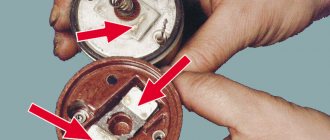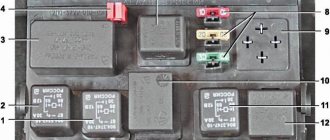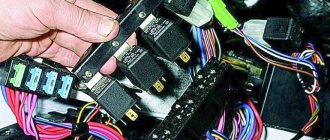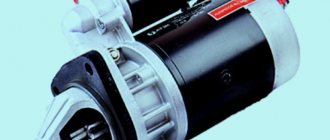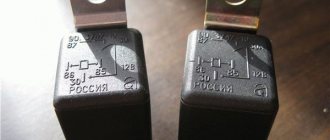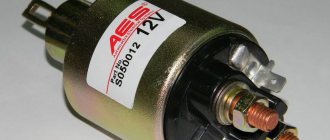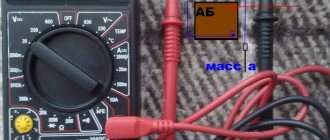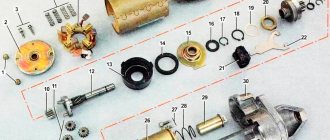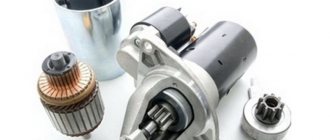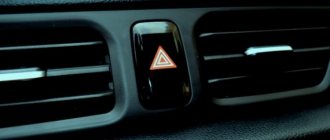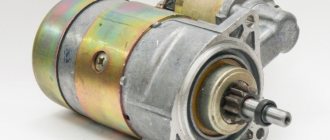The starter solenoid relay supplies current to the starter motor and also pushes out the bendix. This means that the moment the starter starts to rotate, its bendix is pushed out. In fact, understanding the operation of the starter is not difficult. Today we will help you understand how the solenoid relay works, how to check this element and repair it.
Solenoid relay design and operating principle
In the starter, the solenoid relay engages the flywheel crown with the bendix. All work is based on the principles of electromagnetism. The core, which is made as a hollow tube, inside which the armature is located, is equipped with a wire winding. The current in the coil creates an electromagnetic field, as a result of which the armature enters the core. After the current stops flowing, the armature can move freely.
The starter retractor relay includes: housing; magnet with windings; anchor; contacts; return spring. The magnet in the relay is made in the form of a pair of coils - retracting and holding. The relay retractor coil is connected to the electric motor and the control terminal, but the holding coil is connected to the control terminal and is in contact with the housing. When power is applied to the control contact, magnetic induction occurs in the coil, which leads to the appearance of a magnetic field. As a result, the armature compresses the return spring. At the same moment, the bendix rotates, which connects the starter to the car battery. At the time when the contacts close, the retractor winding receives power from the “+” terminal, the production of current in the coil stops, but the armature is affected by the field of the holding coil, so it remains inside. When the vehicle's power unit starts, the power is cut off, causing the armature to return to its original position under the action of the return spring. The contacts open, which can cause the bendix to disengage.
Common solenoid relay failures
The main reasons for failure of the starter solenoid relay are as follows: Physical wear. Burnout of contact plates. Destruction of components. Winding combustion. How to determine that the solenoid relay has failed:
The engine starts, but the starter does not want to turn off, constantly rotating. At this time you hear a characteristic buzzing sound. The starter rotates after starting, but cannot start the engine. When the key in the ignition switch is turned to its original position, the starter click is heard, but it does not want to rotate. How to check the starter solenoid relay As mentioned above, the operation of the solenoid relay, as well as the starter itself, is based on the principle of electromagnetism. When voltage is applied to the windings, the relay acts on the armature. This, in turn, changes the position of the Bendix gear so that it engages with the flywheel ring. At the same time, the contacts close, providing voltage to the starter windings. In order for the car engine to start, all this must happen very quickly. The article was published in the Machines public page. If at least one of the elements does not work correctly, you will not be able to start the car. To check the starter relay, you do not need to remove this element from the car. Experts advise closing the contact bolts located on the back of the relay using a piece of wire or metal. As a result of this, you will ensure the supply of current to the starter windings. If this caused the starter to rotate, you can conclude that the starter is working normally, and the problem lies in the relay itself. If the retractor clicks and the starter does not turn, this indicates that the relay is probably working, and the cause of the breakdown must be looked for directly in the starter.
Repair of starter retractor relay
If you have come to the conclusion that the starter traction relay has failed, you need to repair it. We would like to note right away that in most cases it is much easier to replace this element than to restore its functionality. Many manufacturers produce non-separable relays in order to make this unit the most reliable. In such situations, you will simply have to replace the solenoid relay with a new one. If the starter in your car is equipped with a detachable relay, you can repair it yourself. Often the relay does not work for the following reasons: the mechanical drive has worn out and failed; a short circuit has occurred in the winding; “nickels” or contacts were burnt. Each of the above faults can be determined after disassembly. vk.com/cars.best True, to determine the integrity of the windings you will have to use an ohmmeter. When measuring the resistance between the ends of the wire and the body, this indicator should be at least 10 kOhm. Otherwise, the windings have shorted, so you will need to go to the store for a new relay.
Installation of a new or restored relay is carried out in the reverse order of dismantling. Many car enthusiasts at this stage have a problem, which is how to connect the starter relay. In order to avoid such troubles, we recommend that you first mark the disconnected terminals. Before installing the relay, be sure to thoroughly clean the contacts and degrease them.
Possible starter problems:
If you are trying to start the car, but there are no sounds, make sure that the battery is not discharged (check with a device, the voltage should be at least 12 V), and also check that there is good contact between the wires on the battery. Sometimes the wire landing spots become oxidized. If you see traces of oxidation, then clean the terminals and contacts on the battery. Use fine sandpaper or a knife to clean.
If you start the car, but again the engine does not start, but you hear clicks from the traction relay (the battery is well charged), then there are two options - a malfunction of the relay contacts, or a malfunction of the starter motor.
If you are trying to start the car and you cannot hear the clicks of the traction relay, then most likely there is a malfunction in the traction relay, or a break in the wiring.
If you hear that the starter is spinning, but very slowly, then again check the voltage that the battery produces. This can be done using the device. The voltage should not be less than 12 V.
And finally, if you are sure that the battery is charged and there are no problems with the wiring, then remove the starter along with the traction relay for a more detailed check.
What tool is needed to check the VAZ 2110 starter? It’s quite simple, you will need a flat-head screwdriver and high-voltage wires with alligator clips (popularly called “lighting” wires).
Basic car starter malfunctions
Starter malfunctions are divided into two categories
- mechanical failure or wear
- damage to the electrical circuit
Since the motor shaft spin-up device consists of two electrical elements, damage to the electrical circuit is also divided into two subcategories:
- electric motor malfunction
- Solenoid relay malfunction
Malfunction of the mechanical part of the starter can be repaired by replacing the bearings or bendix.
Blendix VAZ 2110 in perfect condition
Failures of the electrical component of the structure are eliminated by replacing the entire blocks, perhaps with the exception of replacing the carbon brushes.
How to check the VAZ 2110 starter:
The first step is to check that the freewheel moves easily along the shaft. This can be checked using a screwdriver.
If it moves freely, then the next step is to check the gear movement. We also try to turn it using a screwdriver. The gear should rotate easily relative to the clutch hub in the direction of rotation of the armature. The gear should never turn in the opposite direction.
To check the functionality of the retractor (traction relay), you need to perform the following steps:
We take high-voltage wires with crocodiles. We connect one of the wires like this: one end to the negative of the battery, the other end to the starter housing. The second wire is connected at one end to the plus on the battery, and at the other end to the terminal of the control wire of the retractor. When connected in this way, a click will occur and the drive coupling will slide out. If this happens, then everything is fine with the retractor. If not, replace the solenoid relay.
Now let's check the operation of the starter motor. To do this, do not touch all the wires that were connected in the paragraph above. The only thing that needs to be changed is to remove the high-voltage wire from the control input of the traction relay and connect it to the lower contact bolt of the traction relay. With this connection, the starter armature will spin at a speed of 5000 rpm. If this does not happen, then the problem lies in the starter motor. Therefore, it needs to be repaired or replaced.
Checking with the starter removed using a multimeter
This test of the solenoid relay allows you to very accurately perform internal diagnostics and determine the condition of the windings and contacts. Dismantling the starter, depending on the make of the car, is carried out in various ways. For VAZ 2110, this procedure is carried out from below from the pit. Before unscrewing the fasteners, remove the wires (it is better to mark the terminals so as not to confuse them during assembly); you may need to remove the crankcase protection.
To begin with, voltage is applied from the battery to the body and terminals of the relay; operation is accompanied by a characteristic click and visible movement of the rod. Further checks are carried out using a multimeter, which is switched to resistance measurement mode and the range of 200 Ohms is selected.
Video: Checking the starter removed from the car
First, check the serviceability of the retractor and retention coils. To do this, one of the probes is connected to ground, the second touches the contacts in succession. The device readings are 2 ohms. Deviation of the device readings from the specified value is a sign of a break or short circuit. To check the power contacts, remove the core from the relay body and remove the return spring, after which the core is inserted back. The core rod is pressed against the table with a certain force and the resistance between the contacts is replaced. The resistance is approximately 1.5 ohms.
How to check the starter retractor relay of a VAZ 2110
Problems with starting the car, strange sounds or a “buzzing” sound after turning the key in the ignition switch are symptoms characteristic of a breakdown of the starter retractor relay. Failure does not always appear immediately. The device works normally for some time without showing any signs of malfunction. But at a certain moment everything changes, and the engine refuses to start.
In such a situation, the best way is to replace the solenoid relay. The question is how to do this on VAZ-2110 cars (watch the video on how to check and how to replace the solenoid relay below). The malfunction can manifest itself in different ways, namely: the absence of any action when trying to start the engine, the appearance of relay clicks, the inactivity of the starter, and so on.
Whatever the symptom, replacing the starter relay on a VAZ-2110 is not as difficult as it seems. At the same time, you don’t need to spend money on a service station - you can do all the work yourself, with your own hands.
What you need to know about the solenoid relay
The electric starter motor of the domestic “ten” is turned on remotely, through the clutch of the flywheel and the bendix. This is possible thanks to the action of the starter solenoid relay, consisting of the following components:
- Two coils. One of them is retracting (connected to the control element), and the second is holding (connected to the control terminal).
- Three systems (magnetic, contact and returning).
- Pipes with anchor. The device consists of a core containing a copper winding. The ends of the wire are brought out to the terminal block. One of the wires is connected to the electric motor and the control contact, and the second is connected to the control terminal and the housing.
This is interesting: What is not taught in driving schools, but should be?
The best solution, if a malfunction is detected, is to replace the starter relay. The main thing here is to carefully approach the diagnosis and make sure that the reason is in the starter. This is logical, because starting problems are often associated with other troubles - discharge of the car battery, damage to the integrity of the wires, the appearance of scale, deterioration in the quality of contact connections, and so on.
How to check the starter
To verify whether the starter is working or not, you will need a battery and a pair of wires. The first step is to dismantle the starter, then take the first wire and connect it to the “plus” of the power source and one of the outputs of the solenoid relay. Attach the second wire to the negative terminal and connect it to the starter ground. The presence of a click indicates that the Bendix is working properly.
Pay attention to the nature of the sound. Ideally, the click should be quick and sharp. If it is tight and sluggish, we can confidently say that the mechanism is faulty.
Video: Checking the solenoid relay and starter contacts
If the video does not show, please refresh the page or » style=»color:#CC3333″>click here
If the checks show a breakdown of the starter, go to the store to select and purchase a suitable spare part. If the device has a non-separable body, replacing the solenoid relay will be sufficient. In a situation where a collapsible starter is installed on the machine, proceed as follows:
- Remove the screws that secure the relay housing cover. In some cases, use a soldering iron to disconnect the winding wires (if they do not allow you to remove the cover).
- Check the condition of the power contacts. Often they are the cause of the malfunction. The best solution is to establish a new contact group. In a situation where the damage to the contact is minor, treat the surface with fine-grain sandpaper.
- Assemble the product using the reverse algorithm.
How to choose a new solenoid relay
Please note that the retractor relay is located in the engine compartment and is mounted directly on the starter. Once you have found the device, all that remains is to change it. To eliminate mistakes when replacing the starter relay, remove the old assembly and take it with you to the store. This way you eliminate the risk of buying the wrong part. In addition, manufacturers put special markings on the solenoid relays, which simplifies the choice.
The part is fixed using 3 screws. To avoid complications in the future, buy four copper nuts and washers. The advantages of such products are resistance to burning, which simplifies subsequent twisting.
How to change the solenoid relay
To replace the solenoid relay on the “ten”, prepare a tool and do a number of preparatory measures.
To begin with, discard the mass (“minus”) of the car using the key to “ten”. After removing the contact, find the starter, which is mounted in the lower part of the engine compartment (in the space between the cooling system and the engine block). Next, proceed like this:
- Connect a couple of wires to the solenoid relay, then discard the red wire (coming from the male connector).
- At the back of the relay, tighten a couple of nuts using a thirteen wrench.
- Take a flathead screwdriver and use it to push the cord away from the front of the fastener.
- Release the relay and then move it to the side.
When doing this work, make sure that the core remains inside and the relay spring does not fall out. This moment, in the process of replacing the solenoid relay, causes the greatest difficulty for car owners. To install a new part, perform the same steps, but using the reverse algorithm. Please note that the old core remains in place, so the new relay is installed without it, but with a new spring.
- Now take a flathead screwdriver and screw the wires into the front of the relay.
- Next, connect to the wires and screw in the nuts using a “thirteen” wrench.
- At the final stage, tighten the nuts that secure the power wire and are connected to the male connector.
As you can see, replacing the starter relay is not difficult even for a beginner. To successfully complete the work, little is required - a tool, time and strict adherence to instructions. If difficulties arise, you can always use photo or video materials.
Video: Replacing the starter solenoid relay
If the video does not show, please refresh the page or » style=»color:#CC3333″>click here
Starter relay on VAZ 2109: fault diagnosis
If your car stops starting at any point, the cause may be the starter solenoid relay. But the best thing to do is check this first.
Appearance of the device
Finding the problem
If the battery is charged and there are no disturbances in the electrical circuit, then the reason lies in the starter itself or its components - the starting and solenoid relay.
On VAZ 2109 vehicles, the starter activation relay is used to activate the windings and transmit torque from the rotor to the flywheel. When the engine starts, the relay disconnects the drive and turns off the power.
Element Role
All VAZ cars, including model 2109, have a standard engine starting system, which is based on an electric starter. Here's what you need to know about him.
- A starter is a small electric motor that is connected to the flywheel of the motor via a coupling (Bendix) for a short period of time to start the rotation of the flywheel.
- Despite its small dimensions, the starter passes through itself enormous currents.
- If the starter circuit were closed directly in the ignition switch, then not a single component of the system would be able to withstand such current loads. As a result, they would burn out.
- Therefore, for these purposes, the starter is connected remotely to the battery via a relay. Its contacts are designed for high currents.
- The starter operates briefly and must be turned off after the engine starts. Otherwise, its active destruction will begin due to the influence of motor power.
- Relyushka performs these tasks perfectly. Actually, it is precisely to ensure the functioning of the system and protection against current, timely shutdown of the starter, a retractor relay is included in the design.
Element diagram
Checking status
Before changing the relay, make sure that the problem with starting the engine is related to this component.
To do this, consider two situations that indicate its malfunction.
| Situation | Your actions |
| The relay makes clicks, but the armature does not spin | If there are clicks from the relay, check the condition of the armature. To do this, the terminals of the retractor relay are bridged with a large screwdriver or a piece of welding cable to the terminals at the ends. Taking a thin wire or a screwdriver can easily burn the terminals. When the armature is working, after closing the terminals, the armature will spin, which can be determined by the sound. Consequently, the solenoid relay itself has failed and requires repair. |
| The relay is completely silent | Even if there is silence after closing the terminals, the problem should be looked for in the starter. The relay no longer plays any role here. |
Having discovered that the relay has served its purpose, it must be replaced or repaired, if possible.
Dismantling
There should be no problems with the dismantling process. The main thing here is to remove the starter, since the required relay is held on it. Therefore, dismantling is carried out as an assembly.
- Turn on the handbrake, disconnect the battery by removing the negative terminal from it.
- A wire with a large cross-section goes from the battery to the contact of the relay. It can be turned off by unscrewing it using a 13 key.
- Remove the thin winding power wire from the solenoid relay.
- Using the same 13mm wrench, unscrew the three mounting nuts holding the starter to the clutch block.
- You can remove the device through the bottom or top. If you chose the top, then you need to slightly rotate the starter around its axis and remove it.
- The lower output is more difficult, since here you need to remove the crankcase protection. But if parallel work is carried out that requires similar manipulations, problems will not arise.
Repair
Next, you have a choice to make: replace the entire relay or try to repair it.
Only a relay that has a collapsible design can be fully repaired. It is not uncommon for cars to have a relay with a non-separable body. Repairs there are also possible, but only partial.
- Unscrew the pair of bolts that hold the relay on the starter, disconnect the core shackle from the upper end of the drive lever;
- Install a new solenoid relay in its place, thereby completing the replacement.
But if you want to save money or just like to tinker with your car, you can try to bring a damaged relay back to life. To do this, we offer you detailed instructions.
The most vulnerable spot of this unit is the contacts where the wires are soldered to the terminal. It may have oxidized or was simply of poor quality to begin with. Therefore, before disassembling the relay, solder the contacts with a soldering iron. In most cases, the operation of the relay returns and there is no need to disassemble the case.
Disassembled element
If this measure does not help, we will disassemble the case and repair it.
- The relay consists of a housing with a winding inside, a core with a return spring and contacts.
- The spring disconnects the starter rotor gears from the Bendix ring when the power to the relay winding is turned off.
- The back cover of the relay is fixed with screws to the body. Therefore, the first thing we do is remove this cover by unscrewing the corresponding fasteners.
- Both contact bolts have a nut, which you also unscrew.
- You will see washers under the nuts. Do not lose them so that you can return them to their place during reassembly.
- Unsolder both terminals of the winding using a soldering iron. Then remove the cover.
- If you find traces of carbon on the contacts, they can be removed with a small file.
- There is a rubber O-ring under the cover. Check it for elasticity and integrity. If the ring is damaged or worn, replace it with a new one.
- Remove the contact plate along with the rod.
- Use a flathead screwdriver to remove the return spring.
- If the spring is deformed or stretched too much, it will need to be replaced. Otherwise, a worn spring will not be able to guarantee the desired contact. As a result, the relay does not work properly.
- Disassemble the contact plate. To do this, you need to remove the retaining ring that insulates the washer. After this, the plate will fall out on its own due to the pressure created by the spring.
- Remove the contact bolts from the cover. Clean the surfaces of their contacts. Often, due to burning of the contact surfaces, the solenoid relay stops working normally.
Contact bolts
- If the carbon deposits are too strong and cannot be removed with simple sandpaper, do not rush to buy new bolts. Just rotate them 180 degrees. So they will touch on the other side, where there is no carbon deposits.
- The relay windings are located in a non-separable housing. If they are damaged, you will have no choice but to completely change the relay.
- Replace all damaged and worn elements of the switching relay, and then put everything back into the housing. Reinstall the solenoid relay and check if the ignition returns to normal.
If the relay has a non-separable housing, many recommend replacing it. But if you wish, you can even repair such a unit. To do this, you need to flare the housing with pliers, then unsolder the contacts and remove the cover. Next, follow the instructions given above.
The last stage of replacement or repair is checking the winding resistance.
If the unit is working properly, the multimeter in ohmmeter mode will show you the following data.
| Measuring area | The indicator is normal |
| Between blade contact and bottom relay bolt | The resistance in this area should be about 0.5 Ohm |
| Between blade contact and body | When checking this area, you need to get 0.7 Ohms with an acceptable small error |
Checking status
If there is a significant deviation from the norm, replace the repaired relay or check a new one. It could be defective or counterfeit.
No Comments Yet! You can be first to comment this post! Close Window
Loading, Please Wait!
This may take a second or two.
luxvaz.ru
How to test the starter relay
The starter relay is an important part responsible for turning on the car engine, synchronizing the operation of all parts and distributing electricity. It is not difficult to check its functionality, but it requires following all the instructions.
When starting a car engine, not every driver thinks about where this difficult process begins. The starter relay plays an important role in this chain, and its breakdown often stops the car. The replacement process is not as complicated as it seems at first glance, but for this we will consider the components, the principle of operation and the repair process itself.
Concept and principle of operation of the starter relay
A starter solenoid or traction relay is a necessary attribute of every car. It works in conjunction with the engine starter and performs an important function. In addition to the starter relay, the engine starting mechanism contains a gear and a flywheel. It is through the starter relay that the gear and flywheel are engaged and disengaged at the moment of starting. This is necessary to ensure that the starter itself works correctly and lasts a long time.
The starter solenoid relay consists of such main components as a relay body, an armature, a spring, windings with an electromagnet and a pair of contacts.
The principle of operation of the starter relay is that when the ignition key is turned on, a magnetic field is formed, which moves the armature into the housing. Then the magnetic field ceases to act, but the coil creates its own field, which does not allow the armature to return to its original position. Then the bendix gear moves along with the armature, and finally it engages with the flywheel.
After this, the contact pairs close, resulting in the formation of a current that begins to rotate the rotor together with the flywheel. In order to unhook the gear together with the armature, the starter relay comes into action. With its help, the magnetic field is turned off, and thus the armature and the gear return to their original position.
The VAZ 2110 starter buzzes, but does not turn the engine.
Indicates that the electrical circuit is being closed and power is being supplied to the motor brushes. The electric motor is in working condition. The holding coil of the solenoid relay does not operate and the bendix does not move. Bendix gear does not engage with flywheel gear. The electric motor runs in idle mode. The cause may be either mechanical or electrical in nature.
Mechanical part. The force from the relay retracting element is transmitted to the bendix through a plastic lever shaped like a grip. If there is high resistance to the movement of the bendix along the rotor shaft, this plastic part breaks. The Bendix does not move to the working position, and the starter rotates without transmitting torque to the flywheel.
An indirect cause of failure of the plastic grip may be wear of the teeth on the rotor shaft of the electric motor or wear of the teeth on the mating part of the bendix. For repairs, you will need to disassemble the starting unit and replace either the lever itself or the lever and bendix.
Another mechanical reason for the starter idling is the destruction of the teeth on the engine flywheel. The malfunction refers to a motor failure and is not directly related to the operation of the drive. The likelihood of such a malfunction may be indicated by the activation of all working elements of the starter, the spin-up of the electric motor and the transfer of the bendix to the working position, which is detected by a characteristic click when turning the ignition key.
Basic starter relay faults
Like any other part, the starter relay may experience technical problems with its operation. They may appear as follows. The most obvious cause of the malfunction is that the starter simply does not engage and thus the engine does not start. The opposite problem is that the starter does not stop working after the engine starts.
This also indicates a problem in the mechanism. Also, often the starter does not have enough revolutions to spin the flywheel and thus turn it on. Another cause for concern is the absence of a click when the ignition key is activated, which signals that the armature has been pulled into the housing and the gear is engaged with the flywheel. If it is not there, then the mechanism did not work. However, there are times when the click is triggered, but the starter device still does not work. The problem most likely lies in burnout of contact pairs.
There can be many reasons for the above problems. First of all, obvious wear of parts that prevent the starter from working correctly may catch your eye. In this case, the solution to the problem is to replace parts. Contact pairs or windings may also burn out, as mentioned above. To troubleshoot, as in the first case, a complete replacement of parts is necessary. In addition, the anchor may move into the hull with some delay and difficulty.
VAZ 2110 starter relay and where it is located in the car
Those people who have a VAZ 2110 have certainly encountered a situation where the starter did not turn after the key was turned, and some clicks are heard, which indicate that the retractor relay is working. In such a situation, the question immediately arises: where is the VAZ 2110 starter relay located and how to find it faster. This question is also relevant when tuning a VAZ 2111.
But we have interesting news for you: the VAZ 2110 simply does not have a starter relay. There is a solenoid relay, to which the positive contact is supplied from the ignition switch. The relay is installed on the starter, its size is 2 times smaller than that of the starter, and it is round in shape.
Next, we will highlight some popular malfunctions that usually arise in the VAZ 2110, related to the VAZ 2110 starter relay and the starter; by the way, a lot of things are used in the VAZ 2115, so by tuning this car, many problems can be avoided.
Basic starter malfunctions
The traction relay does not operate after the ignition key has been turned, and the armature does not rotate.
In this situation, it may be due to the following possible problems:
- the battery is broken or discharged, the solution to this problem is to buy a new battery or charge it;
- the positive contacts have oxidized - you just need to clean them;
- it happens that an interturn short circuit occurs on the winding of the traction relay - to correct this situation, you need to install a new relay;
- the circuit that powers the traction relay has broken - you need to check the wires for integrity, and whether they have become disconnected from the circuit?
- contacts “30” and “50” do not close - you just need to change the contact part of the ignition switch;
- The traction relay armature does not work well - you need to remove it and disassemble it, there may be a lubrication problem.
After turning the key, the starter does not start, the armature rotates slowly, and a click is heard in the traction relay.
This situation may arise due to previously similar situations:
- the battery is discharged or disconnected - you need to check and correct the situation;
- the winding of the traction relay is shorted or broken - you also just need to change the relay;
- the ends of the wires have seriously succumbed to oxidation - they need to be checked and cleaned, starting with the battery.
After turning the key, the starter armature spins, but the flywheel does not spin.
This situation arose due to the fact that:
- the freewheel is slipping - you need to diagnose the starter at the stand and replace the clutch if it is faulty;
- The gears on the gearbox are worn out - you just need to replace them.
The starter makes a lot of noise when the armature is spinning.
This problem arose because:
- The liners on the armature or drive shaft bearings have served their service life - you just need to replace the parts that have failed;
- the starter is not secured properly, and the cover could have broken - you just need to secure it or change it;
- the gears on the gearbox, flywheel crown or drive have failed - you just need to change them, or immediately replace the non-functioning parts entirely.
- the gear is constantly engaged with the flywheel; if the clutch on the shaft splines is stuck, it is possible that the armature of the traction relay is stuck - to solve this problem, you need to lubricate the splines with oil. And if the traction relay is stuck, then you need to either change it or use certain methods to get rid of the jam.
VAZ 2110 starter relay: installation
And then a video on how to install an additional starter relay on a VAZ 2110:
How to test the starter relay
First of all, the problem with the engine not working may be due to damaged wiring. Therefore, the check should begin with it. If it is in perfect working order, you should check the starter relay. There is a high probability that it simply does not work.
If a click is heard, but the engine does not start, you should check the functionality of the contact pairs. To do this, use a screwdriver to remove the terminal and connect it to the starter terminal. In this case, current must flow and if the motor fires, then the contact pairs are not damaged, and the problem lies in other parts.
A complete check of the starter relay also includes a voltage check, since a lack of energy causes the flywheel to not rotate sufficiently, and thus the engine cannot be started. In this case, you will need a special multimeter. One probe must be connected to the positive terminal, and the other to ground. Then you should turn the ignition key and look at the multimeter readings. If they are below the available standard, it means there is not enough voltage to start the engine.
All these procedures can be carried out without removing the starter from the car, which makes the work easier. However, if a complete inspection of the relay with its removal is required, you should remember the safety rules. The torque is quite strong, so it is best to place the device on the ground at a safe distance. Parts must also be disassembled with caution, as incorrect inspection can cause serious injury.
How to replace the starter relay
You can replace the starter solenoid relay yourself, strictly following all the instructions. When working to replace parts or replace the starter relay itself, you should clean them of dirt, as they can impair further operation and lead to a short circuit. Replacing the starter relay begins with removing it from the vehicle. This procedure is quite difficult.
To do this, we place the car in a cautious pit. We begin the replacement procedure by disconnecting all wiring by unscrewing the nuts for safety reasons. Then the upper and lower bolts are unscrewed, with the help of which the starter and relay are attached.
Next, install the new device. This should be done in strict reverse order. Finally, you should connect the wiring and then check the functionality of the entire device.
Car starter relay repair cost
You can do all the work of checking and replacing the starter relay at any car service center. This procedure will be more reliable, since it will be performed by qualified specialists. The cost of this service starts from $10 and above. The cost of the starter relay part itself ranges from $10 to $25, depending on the car model and the quality of the mechanism. If you take a foreign car, the price may be higher than $50.
This is interesting: How long after a feast can you drive?
Video of replacing the VAZ starter relay:
Operating principle of the starter solenoid relay, check, connection diagram
Any movement of a car begins with starting the engine. That is why for the entire system to function properly, it is necessary that the device that starts the engine is in perfect order.
If you believe the statistics, then most often the starter solenoid relay fails in the starting system. However, most drivers know about this. Despite this, when problems with starting the engine begin, many experience a real shock. The main embarrassment of the situation is that it will not be possible to take the car to a service center.
There are, of course, tow truck services. But, firstly, it is expensive, and secondly, in some places there are simply no companies providing such services. Therefore, knowledge of how to restore the starter solenoid relay and how it generally works will not be superfluous.
What is a starter solenoid relay?
So, let's start with the basics. Two relays are responsible for the starter. The first is installed in the engine compartment. The design can have its own housing or be installed in a common unit.
In this article, we will be much more interested in the second relay, which is responsible for the operation of the starter, namely the retractor. It performs the following functions:
- redistributes energy between the starter and the electromagnetic relay;
- feeds Bendix gears;
- synchronizes the starter components,
- returns the gears to their original position after you turn off the engine.
In the automotive world, this unit has two names: traction and retraction. The first is most often used in specialized literature, the second is popular.
To understand why a starter solenoid relay is needed, let’s look at the engine’s operation schematically. To start the engine, the crankshaft must begin to rotate. Only after this does the fuel-air mixture ignite in the combustion chamber.
Usually the engine starting process takes place within a second. The role of the relay in it is quite simple. Thanks to it, the gear elements engage with each other. It synchronizes the operation of the starter. This unit also removes the bendix from the flywheel.
Operating principle of the solenoid relay
Before moving directly to the malfunctions and methods for eliminating them, it will be useful for car owners to know the device of the starter retractor relay and how it works. It is immediately worth noting that the mechanism is a classic electromagnet , consisting of two windings (holding and retracting), a circuit for connecting it to the starter, as well as a core with a return spring.
When the ignition key is turned, voltage from the battery is supplied to the coils of the solenoid relay. This creates an electromagnetic field that moves the core located in its body. That, in turn, compresses the return spring. As a result of this, the opposite end of the “fork” moves towards the flywheel. In this case, the gear connected to the bendix is squeezed out until it engages with the flywheel ring. As a result of engagement, the contacts of the built-in starter circuit are closed. Next, the retracting winding is turned off, and the core remains in a fixed position with the help of a working holding winding.
Scheme of operation of the solenoid relay
After the ignition key turns off the engine, voltage to the solenoid relay stops supplying. The anchor returns to its original position. The fork and bendix, which are mechanically connected to it, disengage with the flywheel. Thus, a malfunction of the starter solenoid relay is a critical failure due to which it is impossible to start the engine.
How it all started
It is worth recognizing that the starter retractor relay is one of the oldest parts of the car. It was invented back in 1912. The authorship of the invention belongs to Charles Cuttering. This is the legendary founder of the Delco company, which continues to thrive to this day.
By the way, it was the invention of the starter retractor relay that allowed women to drive cars on an equal basis with men. The fact is that before this important discovery, cars were started using a handle that was inserted into a pulley. Then it was necessary to twist it, only after that the car could move. Of course, this required a lot of effort.
Principle of operation
To understand how the starter solenoid relay works, let’s remember a regular electromagnet. The basic principle is the same. The unit consists of two windings: retracting and holding. The design also includes a starter and core activation circuit.
The end of the starter traction relay armature is connected to the plug. The whole structure works on the principle of a lever. The fork is fixed in the central part. It is the end opposite the main unit that moves the bendix. This happens when the electromagnet of the core responsible for retraction is triggered.
The fork, fixed on the axis in the central part, with the end opposite to the retractor relay, moves the bendix when the electromagnet that retracts the core is activated.
When you turn the key in the ignition, voltage is applied to the winding. As a result, a magnetic field is formed. It moves the armature, which compresses the return spring.
The end of the fork moves towards the flywheel. The gear is pushed out and connected to the bendix. Moreover, this happens before the connection with the toothed flywheel occurs.
When engagement occurs, the contacts close. They are integrated into the design of the starter solenoid relay. Two circuits take part in this process, one more powerful and the other weaker.
The first is needed to overcome the spring resistance. During its operation, the retractor winding is deactivated. The anchor, in turn, is fixed. The corresponding winding is responsible for holding it.
When you remove the key from the ignition, the contacts open. The current supply stops. The windings are de-energized. As a result, the spring returns the armature to its place, and the bendix opens with the flywheel.
Solenoid relay device
- The copper contact plate is attached to a pin screwed into the relay core, and a large current flows through the plate.
- The plate is insulated from the stud using special textolite washers; it is pulled to the extreme right position using an electromagnet.
- Powerful springs located between the plate and textolite washers create an even and tight fit of the plate to the contacts.
- The traction relay is closed with a cover secured with screws. There are two fixed copper contacts in special holes, through which electric current flows to the electric motor. The contacts are integral with the contact bolt and are secured with copper nuts. From one contact the wire is connected to the battery, the second to the electric motor.
The main malfunction lies in the weakening of the contact connection as a result of the passage of a large current; when it passes through the weakened contacts, heating is observed and, as a result, oxidation of the contacts appears. To increase the resistance to oxidation, the contact connection is sealed with special gaskets and shaped seals.
Diagnostics and repair
Checking the system
Before checking the solenoid relay, you need to test the starter itself. This check will allow you to understand what exactly is not working in the system. Insert the key into the ignition and turn it.
Next you will need to open the hood and get to the starter. You must make sure that this is the case. To do this, bridge the two contacts. They are made in the form of two copper bolts. These structural elements are attached to the rear of the solenoid relay (on the body). If, after the manipulations you have performed, the mechanism rotates, then the problem is in the solenoid relay.
In some cars, reaching the starter is very difficult, and sometimes even impossible. In this case, you will have to partially disassemble the system and dismantle the device itself.
After removing the starter, place it on the ground. Place the battery nearby. Connect the leads of the two devices. In this case, the battery ground is connected to the starter ground.
When the wires are connected, the starter solenoid relay will operate. At first there will be a rather loud click. If the mechanism operates too slowly, be sure to check the contacts. This situation may be caused by the fact that they are burnt.
What kind of damage can happen?
Usually the whole problem lies in burnt contacts or their sticking; other faults include:
- coil burnout,
- mechanical damage,
- natural wear and tear of parts.
In the latter case, the starter solenoid relay will need to be replaced. There are a number of signs that most likely indicate that the problem is in this particular node, these include:
- After the engine starts, the starter continues to operate. This is indicated by a clearly audible buzzing sound.
- When you turn the key in the lock, you can hear a distinct clicking sound. This means that the main system starts, but the starter does not work.
- When you turn the key, the starter idles. The engine remains inactive.
These signs most likely indicate that the malfunction is related to the starter solenoid relay.
How to connect
Many motorists are afraid that after they repair the solenoid relay, they will not be able to connect it. In reality, the connection diagram is quite simple. Moreover, you compose it yourself.
To carry out reverse dismantling, you must first mark the disconnected terminals. This will allow you to connect everything correctly after the repair is completed. Also, before installing the relay, you need to clean the contacts. For degreasing, use a modern liquid sold in automotive stores.
Repair
It is worth recognizing that on machines of the same series, the starter solenoid relays are very similar. The most striking in this context is the following automobile line:
In principle, all starter solenoid relays have the same design. Accordingly, their repair process is similar. The main differences lie in the fastening systems. Also, cores can have different designs. But the general scheme is very similar.
So, in order to repair the starter solenoid relay, you first need to dismantle and disassemble it. Here, in fact, lies the main problem. In most cars, these units are non-separable. All that remains for the driver in this case is to make a replacement.
It is very important to maintain a clear sequence during repairs. Otherwise, you risk not only damaging the part or other systems, but also getting injured. The process itself consists of the following stages:
- Disconnect power from the battery.
- Clean the part from dust and dirt. Otherwise, foreign particles may get inside the unit, causing damage to it.
- Unscrew the brush assembly nut.
- Remove the contact from the bolt.
- Unscrew the clamping screws. They are the ones that connect the relay to the ground of the car.
- Unscrew the ends of the nuts.
- Divide the device in half.
- Replace the core.
- Reassemble.
Before putting the device back into the car, start it. Reinstallation should only be carried out after preliminary testing. Once everything is assembled, do a few test runs. Only after this go on the road.
What else could break?
Most damage to the solenoid relay is associated with the burnout of certain of its elements. Most often, electromagnetic circuits burn out. Windings and contacts are also subject to similar destruction. In some cases, the cause of failure is metal fatigue.
However, ignition problems are not always associated with the starter or solenoid relay. If the repair does not give the desired results, check the electrical circuit. Also look at how much charge the battery has.
Signs and causes of relay failure
External signs of a broken starter relay include the following:
- When you turn the key in the ignition switch, no action is taken to start the engine, or starting is possible only after making several attempts.
- After the engine starts, the starter continues to rotate at high speed. This can be heard by ear by the strong buzzing of the mechanism.
A malfunction in the relay is one of the reasons that the car does not start, and there may be several reasons for its breakdown:
- failure (burnout) of the contact plates inside the relay (popularly called “nickels”), reduction in their contact area, “sticking”;
- breakage (burning) of the retracting and/or holding winding;
- deformation or weakening of the return spring;
- short circuit in the pull-in or holding winding.
How to check the starter solenoid relay with a multimeter
If you find at least one of the listed signs, then the next step to fix the problem is to conduct a detailed diagnosis.
